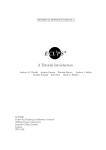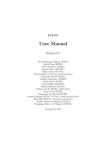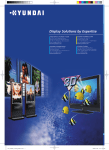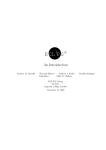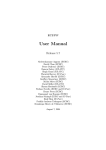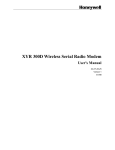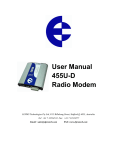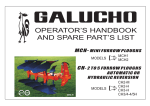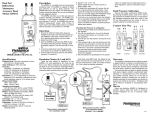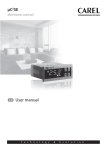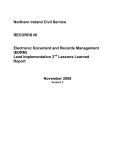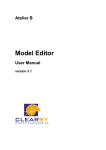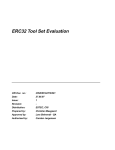Download Atelier B Translators
Transcript
Atelier B Atelier B Translators User Manual version 4.6 ATELIER B Atelier B Translators User Manual version 4.6 Document made by CLEARSY. This document is the property of CLEARSY and shall not be copied, duplicated or distributed, partially or totally, without prior written consent. All products names are trademarks of their respective authors. CLEARSY Maintenance ATELIER B Parc de la Duranne 320 avenue Archimède L es P l éi ades I I I - B ât . A 13857 Aix-en-Provence Cedex 3 France Tel 33 (0)4 42 37 12 70 Fax 33 (0)4 42 37 12 71 mail : [email protected] Contents 1 Description of this manual 1 1.1 Aim . . . . . . . . . . . . . . . . . . . . . . . . . . . . . . . . . . . . . . . . 1 1.2 Required Prior Knowledge . . . . . . . . . . . . . . . . . . . . . . . . . . . . 1 1.3 Overview of this Manuel . . . . . . . . . . . . . . . . . . . . . . . . . . . . . 2 1.4 How to use this Manual . . . . . . . . . . . . . . . . . . . . . . . . . . . . . 2 1.5 Conventions and syntax . . . . . . . . . . . . . . . . . . . . . . . . . . . . . 2 1.6 Related Documents . . . . . . . . . . . . . . . . . . . . . . . . . . . . . . . . 3 2 Presentation of the Software 5 2.1 Purpose . . . . . . . . . . . . . . . . . . . . . . . . . . . . . . . . . . . . . . 5 2.2 Recommended Environment . . . . . . . . . . . . . . . . . . . . . . . . . . . 5 2.3 Provided Services . . . . . . . . . . . . . . . . . . . . . . . . . . . . . . . . . 6 2.3.1 Preface: Reasons for two-pass translation . . . . . . . . . . . . . . . 6 2.3.2 Automatic translation service of a B0 implementation into target language . . . . . . . . . . . . . . . . . . . . . . . . . . . . . . . . . . 8 2.3.3 Linking service . . . . . . . . . . . . . . . . . . . . . . . . . . . . . . 8 2.3.4 Basic Machines . . . . . . . . . . . . . . . . . . . . . . . . . . . . . . 9 3 Use principles 3.1 3.2 3.3 11 Operating Modes . . . . . . . . . . . . . . . . . . . . . . . . . . . . . . . . . 11 3.1.1 Using the Translator via the GUI∗ . . . . . . . . . . . . . . . . . . . 11 3.1.2 Using the translator in batch∗ mode . . . . . . . . . . . . . . . . . . 12 3.1.3 Using the Translator from the command line . . . . . . . . . . . . . 13 3.1.4 Compiling and Executing the Code Produced . . . . . . . . . . . . . 14 Inputs and Outputs . . . . . . . . . . . . . . . . . . . . . . . . . . . . . . . 15 3.2.1 Messages Generated by the Ada Translator . . . . . . . . . . . . . . 15 3.2.2 Using the translator from the command line or the Batch mode∗ . . 15 3.2.3 Using the translator from Atelier B’s GUI∗ . . . . . . . . . . . . . . 15 3.2.4 Files . . . . . . . . . . . . . . . . . . . . . . . . . . . . . . . . . . . . 15 Precautions for Use . . . . . . . . . . . . . . . . . . . . . . . . . . . . . . . . 16 1 ii CONTENTS 3.3.1 Important Proof Related Warning . . . . . . . . . . . . . . . . . . . 16 3.3.2 Important Warning Relating to the Values of the MAXINT and MININT Constants . . . . . . . . . . . . . . . . . . . . . . . . . . . 16 3.3.3 Size of Lines Produced . . . . . . . . . . . . . . . . . . . . . . . . . . 16 3.3.4 Compatibility of the Translator with Atelier B . . . . . . . . . . . . 17 3.3.5 Naming Modules and Projects for the Ada and HIA Translators . . 17 4 Operating scenarios 4.1 19 Developing a native B project . . . . . . . . . . . . . . . . . . . . . . . . . . 19 4.1.1 Principle . . . . . . . . . . . . . . . . . . . . . . . . . . . . . . . . . 19 4.1.2 Informal Example Specifications . . . . . . . . . . . . . . . . . . . . 19 4.1.3 Project Architecture and B Code . . . . . . . . . . . . . . . . . . . . 20 4.1.4 Integrating Components into Atelier B . . . . . . . . . . . . . . . . . 23 4.1.5 Unitary Translation of the Produced Code . . . . . . . . . . . . . . . 23 4.1.6 Project linking . . . . . . . . . . . . . . . . . . . . . . . . . . . . . . 26 4.1.7 Compiling and Executing the target code . . . . . . . . . . . . . . . 26 4.2 Developing a Heterogeneous B/Target Language Project . . . . . . . . . . . 26 4.3 Developement of a Heterogeneous B/HIA project . . . . . . . . . . . . . . . 29 5 Complete List of Services 31 5.1 Unitary Translation of an Implementation . . . . . . . . . . . . . . . . . . . 31 5.2 Project Linking . . . . . . . . . . . . . . . . . . . . . . . . . . . . . . . . . . 31 5.3 Translating a Project with Traces . . . . . . . . . . . . . . . . . . . . . . . . 31 5.4 Restriction of translators use . . . . . . . . . . . . . . . . . . . . . . . . . . 33 6 Glossary 35 A Basic Machines 37 A.1 Principle . . . . . . . . . . . . . . . . . . . . . . . . . . . . . . . . . . . . . . 37 A.1.1 Definition . . . . . . . . . . . . . . . . . . . . . . . . . . . . . . . . . 37 A.1.2 Usefulness . . . . . . . . . . . . . . . . . . . . . . . . . . . . . . . . . 37 A.2 Description of the Basic Machines Delivered with Atelier B . . . . . . . . . 37 A.3 Writing a Basic Machine . . . . . . . . . . . . . . . . . . . . . . . . . . . . . 37 A.3.1 The B Specification writing method . . . . . . . . . . . . . . . . . . 38 A.4 Target code (interface and body) writing method . . . . . . . . . . . . . . . 38 A.4.1 Target Code writing method for Ada . . . . . . . . . . . . . . . . . . 39 A.4.2 Target code writing method for HIA . . . . . . . . . . . . . . . . . . 40 A.4.3 Target code writing method for C++ . . . . . . . . . . . . . . . . . 40 A.4.4 Target code writing method for C . . . . . . . . . . . . . . . . . . . 41 A.4.5 The “B Link File” . . . . . . . . . . . . . . . . . . . . . . . . . . . . 42 CONTENTS iii B B0 specifities accepted by the HIA translator 43 B.1 Introduction . . . . . . . . . . . . . . . . . . . . . . . . . . . . . . . . . . . . 43 B.2 Arrays translation . . . . . . . . . . . . . . . . . . . . . . . . . . . . . . . . 43 B.2.1 Principle . . . . . . . . . . . . . . . . . . . . . . . . . . . . . . . . . 43 B.2.2 Example . . . . . . . . . . . . . . . . . . . . . . . . . . . . . . . . . . 43 B.3 Record translation . . . . . . . . . . . . . . . . . . . . . . . . . . . . . . . . 44 B.3.1 Principle . . . . . . . . . . . . . . . . . . . . . . . . . . . . . . . . . 44 B.3.2 Example . . . . . . . . . . . . . . . . . . . . . . . . . . . . . . . . . . 44 B.4 Formal parameters . . . . . . . . . . . . . . . . . . . . . . . . . . . . . . . . 45 List of Figures 2.1 Files produced for the mach interface . . . . . . . . . . . . . . . . . . . . . . 8 2.2 Files produced for the mach body . . . . . . . . . . . . . . . . . . . . . . . . 8 3.1 Translation of an implementation in batch mode . . . . . . . . . . . . . . . 12 3.2 Translation of an implementation using the command line 4.1 Specification and implementation of the stack component . . . . . . . . . . 21 4.2 Specification and implementation of the display stack component 4.3 Specification and implementation of the interface stack component 4.4 Specification and implementation of the demo component . . . . . . . . . . 25 4.5 Project dependency graph 4.6 Compilation of an Ada code produced by the Ada translator . . . . . . . . 27 4.7 Executing the Ada program 4.8 Correspondence between the physical instances of the project and their access path in Ada, C and C++ . . . . . . . . . . . . . . . . . . . . . . . . 28 5.1 Translation of an implementation from the command line . . . . . . . . . . 31 5.2 Options available when performing the unitary translation of a component 5.3 Options available during linking . . . . . . . . . . . . . . . . . . . . . . . . . 32 . . . . . . . . . 14 . . . . . 22 . . . . 24 . . . . . . . . . . . . . . . . . . . . . . . . . . . 26 . . . . . . . . . . . . . . . . . . . . . . . . . . 28 A.1 Basic machines supplied with Atelier B 32 . . . . . . . . . . . . . . . . . . . . 38 A.2 Translation of the B0 types in Ada, HIA, C and C++ . . . . . . . . . . . . 39 A.3 Example of a “B Link File” . . . . . . . . . . . . . . . . . . . . . . . . . . . 42 1 Chapter 1 Description of this manual 1.1 Aim This user manual applies to the following softwares : • Ada Translator, since version 4.61 • HIA Translator, since version 4.62 . • C/C++ Translator, since version 4.23 From now on, when we will refer to the Translator software, this will mean that we are evoking the Ada, HIA, C or C++ Translators, indifferently. When we desire to differentiate between the software, we will clearly write Ada Translator, HIA Translator, C Translator or C++ Translator. In the same way, when we will refer to the target language, that will mean that we are referring to Ada, HIA, C or C++ Language. The aim of this user manual is to make the required knowledge available to the persons using the Translator. It has a double goal: • to enable these persons to learn progressively. • to serve as a reference to identify the behavior of this software. To do this, the required prior knowledge, how to access the manual according to the user’s requirements, notation conventions used and useful reading will be exposed. 1.2 Required Prior Knowledge The reader of this manual is assumed to be trained to B and to the target language, as well as in the use of Atelier B and the target compiler. 1 The ADA translator translates all B0 implementations into ADA code in conformance with the Ada83[ADA-83] and Ada-95[ADA-95] standards. 2 The HIA translator translates into “High Integrity Ada” code, syntactically in conformance with the SPARK norm described in [SPARK]. In return for some restrictions on the B language in input, it generates a more simple code, very close to the B0 and “safer” 3 This translator tranlates all the implementations into ANSI-C[ANSI-C] or ANSI-C++[ANSI-C++] code. 1 2 Atelier B Translators - User Manual 1.3 Overview of this Manuel Chapter 2 presents the Translator’s aims. The supported environments and the general translation paradigm are also described. Chapter 3 details the operation principles of the Translator. Its use within Atelier B is described, along with its use through the command line of a shell∗ . The chapter ends with a description of the precautions to be taken when using a translator. Chapter 4 uses a simple example to illustrate the full development cycle for a B project translated into the target language. The case of a B project whose translation into the target language is merged into a larger project written originally in the target language is touched on. Chapter 5 sums up the program use options. It then details the use of the Translator which can be used to manage project configurations by using the SCCS∗ tool. Finally, chapter 6 explains the technical terms used in this document. Appendix A explains the procedure to follow when developing basic machines. 1.4 How to use this Manual A novice user of the Translator may read only Chapters 2, 3 and 4, as an initial introduction. The example presented in this last chapter provides a complete illustration of the use of the program and should allow the user to come to terms with the Translator progressively and completely. Once he gets acquainted with the program, an experienced user will find in Chapter 5 a summary of the options available when using the translator. 1.5 Conventions and syntax • The “computer objects” such as file names, window names or menu items are written using a non-proportional font as shown in the example below: Machine MM.mch. The input/output exchanges between the user and the program are described using the same font. To differentiate inputs from outputs, the messages generated by the program will be preceded by the > sign, as shown in the example below: ls > AA.mch AA_1.imp SCCS • Words that are explained in the Glossary (chapter 6, page 35) are followed by an asterisk, as shown in the example below: “The GUI∗ user”. • The paragraphs describing specificities of one or several translators are preceeded with the symbol and written in a specific font, as follows: This section does not concern the translator... DESCRIPTION OF THIS MANUAL 1.6 3 Related Documents The bibliography (page 47) provides a list of documents that allow a novice user to learn how to use Atelier B and the target language, and which serve as a reference base for experienced users. 4 Atelier B Translators - User Manual Chapter 2 Presentation of the Software 2.1 Purpose The purpose of the Translator software is to perform an automatic translation of the B0 implementations of a project into target source code. The target source code may be compiled in order to realise an independent project, or integrated into a native target language development.1 . The translators are able to translate into Ada, HIA, C or C++ the whole B0 language. There are no restrictions, especially as regards the naming of identifiers : any identifier which may enter into conflict with the target language is renamed by the Translator. Important remark: the HIA translator works with a B0 language that has some specificities detailed in appendix B. So, any component that is successfully analysed by the B0 checker can be translated into the target language. In the rest of this manual, any implementation of a component for which the B0 checker is successfully executed will be called a B0 implementation. 2.2 Recommended Environment The Translator is intended for execution on the same platforms as the Atelier B. The Translator generates a portable target code, in conformity with the current norms. Program options are used to configure the generated code in order to match the target system and the target compiler 2 . In its 4.6 version, the code produced by this program has been tested with a GNU compiler in the following environments: • Sun workstation running Solaris 2.6, 7 or 8 • Hewlett-Packard workstation running HP-UX 10.20 • PC type computer running Linux 2.2 1 This function is used to integrate, into a project written in the target language, the translation of the secure components written in B. 2 In this way, a cross-translation (similar to cross-compiling) can be performed . 5 6 Atelier B Translators - User Manual Important Remark : The user must have a development environment for the complete target language, since no compiler or language interpretation tools are supplied with the Translator. 2.3 2.3.1 Provided Services Preface: Reasons for two-pass translation This section presents technical aspects that may initially be ignored by a novice user (who may in this case refer directly to paragraph 2.3.2). The Translator is used to translate any B0 implementation into target language automatically. A B0 implementation is not translated into a source code in target language in a single call (or pass) of the translator. Two passes are used : • Unitary translation: during this first pass, each B0 implementation is translated into an “object” file, independently from the other implementations. These “object” files produced during the first pass can be re-used by several projects, allowing the creation of B libraries . • linking : during this second pass, the Translator produces in particular the target language files (refer to paragraph 2.3.3). These target language files are specific to the current project and cannot be re-used in another project. The motivations for this two-pass translation mechanism (production of object files then linking) are linked to the following aims of the Translator : • Complete translation of the B0 language. • Accurate and efficient translation. Complete translation of the entire B0 language A certain number of identifier clashes can occur when translating from B0 into the target language : • The B0 language distinguishes between ident and IDENT, which is not the case for the Ada language. • The void identifier in B0 clashes with the void keyword reserved in C++. • The B0 language allows you to write identifiers that comprise more than one ’_’ successive character (such as for example ident__ifier). These identifiers are not valid Ada identifiers. • Some valid B0 identifiers clash with the target language reserved words. For example, package is a valid B0 identifier. Therefore it is clear that a phase of identifier clash resolution, covering an entire project is necessary to perform an automatic and systematic translation from the B0 language to the target language. PRESENTATION OF THE SOFTWARE 7 Reliable and high performance translation This section does not concern the HIA translator which manages arrays and records translation differently. Refer to the B appendix for more details. Reliable translation of B0 arrays requires determining by inference the types of the arrays used and automatically generating the related “array types”. This action must be efficient because two arrays that have the same inferred type in B0 must be translated by two arrays that have the same generated type in the target language, so as to be able for example to copy and compare these arrays. The same problem occurs during the translation of B0 records : it is necessary to infer a declaration of the associated record type. A generation and resolution phase for array and records types that apply to the entire project is therefore necessary for a reliable and high performance translation of the elements of this kind in the B0 language (which does not explicitly type arrays and records), into the target language : C, C++, or ADA (which imposes a strict explicit typing of arrays and records). Resolving implicitly glued data and renaming Resolving implicitly glued data and renaming in a strictly typed language such as Ada or C++ can only be carried out during a linking phase when the Translator has an overall view of the entire project. Creation of the component instances This section applies only to the HIA translator The linker is responsible for the copy (physical copy of the files) of the files for each instance of a project component. So if in a project two instances M1 and i1.M1 of a component M1 are used, then the linker creates two packages: • The package M1, in m1.ads and m1.adb • The package i1_M1, in i1_m1.ads and i1_m1.adb. This package is obtained by copying the package M1 and replacing all the occurences of M1 by i1_M1. Valuation of formal parameters This section applies only to the HIA translator. The HIA translator declares the formal parameters in the associated packages. It then has to define in each package having formal parameters, not only the name and the type of those parameters, but their value too. Therefore, the effective value of a formal parameter is known only during the module importation by another project module (example : in M1, the clause IMPORTS M2(10) : it is in M1 that we know the value 10 of the formal parameter param of M2. But it is in M2 that param : constant INTEGER := 10 must be written. 8 Atelier B Translators - User Manual Target language Ada C C++ After unitary translation mach.str mach.spe mach.spe After linking mach.ads mach.h mach.h Figure 2.1: Files produced for the mach interface Target language Ada C C++ After unitary translation mach.bod mach.bdy mach.bdy After linking mach.adb mach.c mach.cpp Figure 2.2: Files produced for the mach body The linker has then to set up the effective values of the formal parameters, corresponding to the components use in the B project to translate. 2.3.2 Automatic translation service of a B0 implementation into target language This service takes as its input a BO implementation mach.imp and produces the following files : • Two files for the mach interface. One after unitary translating and one after linking. The file names are given in table 2.1. • Two files for the mach body. One after unitary translating and one after linking. The file names are given in table 2.2. • An object file which describes the symbols imported and exported by mach. By default, this file is named mach.blf. Among other things, this file is used to produce the list of substitutions to be applied to the object interface and body files so as to produce the final target files. 2.3.3 Linking service Case of an Autonomous Project In the case of an autonomous project, the linking service takes as its input the name of the specification of an implementation destined to become the entry point for a project as well as the name of the start-up module to be created, and it creates : • All the source files (interfaces and bodies) for the project components. For the HIA translator, files are duplicated for each instance of a component. • The target code for the start-up module of the project. PRESENTATION OF THE SOFTWARE 9 • The interface and the body of the sets module (in Ada) or SETS (in C/C++) for the inferred array and record types, the concrete constants, the abstract sets and the predefined elements (succ, pred, MAXINT, MININT, . . . ). for the HIA translator, this file contains only the predefined sets and functions. • The makefile file which will be used to generate the project. To be usable as the entry point of a project, an implementation must have one, and only one operation, with no input or output parameters. However, the name of this operation can be freely defined. The link editor recursively scans the import links for this machine and thereby translates into target “terminal” code all the object files used by project. Object files are sought for in the lang directory of the project during the translation, then in the lang directory of used libraries, in the order they were declared. Case of a heterogeneous project In the case of a heterogeneous project, the link editor takes as an input the name of the specification of an implementation destined to become an entry point for a project, as well as the name of a start-up module to be created, and produces : • All the source files (interface and body files) for the project components. • The target code for the access point to the B project. This module enables the initialization of all the B components, and then access to all the data and the operations of these machines. • The interface and the body of the sets module (in Ada) or SETS (in C/C++) for the inferred arrays types, the concrete constants, the abstract sets and the predefined elements (succ, pred, MAXINT, MININT, . . . ). • A makefile skeleton that allows the project to be generated. The link editor recursively scans the import links for this machine and thereby translates into target “terminal” code all the object files used by project3 . Object files are sought for in the lang directory of the project during the translation, then in the lang directory of used libraries, in the order they were declared. Important note : Libraries must be translated before the project that uses them! If this is not the case, project linking will fail as the object files of the library do not exist. 2.3.4 Basic Machines The Translator is supplied with B specifications and the object files for a set of basic machines that facilitate the setting up of formatted inputs and outputs, tables indexed by enumerated sets or by intervals, . . . These machines are described in Appendix A. 3 On the other hand, object files from unused components in the project are not translated. 10 Atelier B Translators - User Manual Chapter 3 Use principles 3.1 Operating Modes The Translator may operate in the following three modes: • In the context of a work session using Atelier B GUI∗ . • In the context of Atelier B batch mode. • Through the command line 3.1.1 Using the Translator via the GUI∗ Translating a BO implementation To translate an implementation implementation.imp of a project proj using the GUI of Atelier B, the following operations must be carried out1 : • Using the mouse, select the implementation implementation.imp. • Click on the Translator button. From the window that is displayed, select the target language with Language and then select Selected Only for Components. Then click on the OK button. The translation process is then started. Remark: As described in sub-section 2.1, a component must have successfully passed the B0 checking step before it can be translated. Therefore, if this step was never performed or if the component was modified since the last check was performed, the B0 checking tool will first be invoked for the implementation to translate. This tool may induce the Type Checker invocation for this implementation. If necessary, all required machines may also be analyzed by this tool. Sub-section 3.1.2 provides an example of the messages produced by the Ada translator during translation. 1 Project creation and management operations are not described in this manual, the reader will find their description in [ATB1]. 11 12 Atelier B Translators - User Manual Translator Ada HIA C C++ Command adatrans implementation_1 hiatrans implementation_1 ctrans implementation_1 c++trans implementation_1 Figure 3.1: Translation of an implementation in batch mode In the same way, it is possible to translate several implementations during a single operation by selecting them all. Global project linking To perform linking on all a project’s components, use the mouse to select the file that serves as the project’s entry point. Then click on the Translator button and choose the target language from the Language menu, and All for Components options. The name of the project start-up module is the name of the B project. Sub-section 3.1.2 provides an example of the messages produced by the Ada translator during the translation. 3.1.2 Using the translator in batch∗ mode Translating a B0 implementation To translate an implementation implementation_1.imp of project proj using Atelier B batch∗ mode, type the command given by the 3.1 table.2 : The translator 3 will then produce the following type of output4 : Translating into ADA the file implementation_1 > Entering B0->Ada mode ... > Creating B Extended Tree > Creating package specifications (/home/B/projet/lang/implementation.str) > Creating package body (/home/B/projet/lang/implementation.bod) > Creating B Link file (/home/B/projet/lang/implementation.blf) > Free B Extended Tree > > > Translation into ADA successful If the command is repeated without changing the B0 source file, a message similar to the following is obtained : Component implementation_1 is already translated 2 The project creation and management operations are not described in this manual, the reader will find a full description in [ATB1]. 3 The example output given is produced by the Ada translator, the output is similar for the other translators. 4 The example given is produced by the Ada translator in verbose mode. By default, a more concise output is obtained. USE PRINCIPLES 13 It is then possible to force the translation of the component by disabling the dependence checks function (command ddm or disable_dependence_mode), and then calling the translator. Conversely, the dependence check function can be re-enabled by typing edm or enable_dependence_mode. Global project linking To perform the project linking, first determine the project entry point (in this case, it is input_1.imp) and type the command: Target language Ada HIA C C++ The translator 5 Command ada_all entry_1 hia_all entry_1 ccompile entry_1 c++all entry_1 produces an output similar to the following6 : > Entering project mode > Calling B linker > Entering project mode > Analysing module entree > (entry) exports (constants) > Analysing machine constants > Creating makefile > Creating ada source code for executable module (project.bod) > Analysing instance this > This instance does not have a SEES clause > Analysing instance this.ref_constantes > This instance does not have a SEES clause > Analysing imported variables of instance this > This module does not import any variable > Analysing imported variables of instance this.ref_constantes > This module does not import any variable > Creating template for package sets > Installing project > Creating temporary bed file /tmp/blka04747 > Executing "/home/ada/bed/bed -s /tmp/blka04747 -i /home/B/project/lang/makefile.blf > -o /home/B/project/lang/makefile" ... > Executing "rm /tmp/blka04747" > Freeing allocated objects > > ADA translation successful 3.1.3 Using the Translator from the command line Chapter 5 presents the provided command line options to use when using the Translator. Note that this possibility should be reserved to experienced users since : 5 The sample output given here is produced by the Ada translator. The other translators produce similar output 6 The example given is produced by the Ada translator in verbose mode. By default, a more concise output is obtained. 14 Atelier B Translators - User Manual Translator Ada HIA C++ C Software tbada tbhia tbcpp tbcpp -c Figure 3.2: Translation of an implementation using the command line • When used from the command line, the translator requires you to provide many parameters : project database directory (bdp), project translator directory (lang), full path for the linker replacement tool (bed tool), path to the directory holding the information of the LIBRARY project, . . . • If you use the Translator from the command line, you must deal yourself with the dependences. For instance, if B source files are modified, you must not forget to re-translate each component that uses them, . . . The array 3.2 gives the name of each translator. In the following examples, we will assume that we want to translate into C++ a B project named my_project. We must therefore know the following information : Identifier ${My_Project}/lang ${My_Project}/spec ${AB}/press/lib Entry Meaning Path to the translation directory Path to the B source code Path to the LIBRARY project provided with Atelier B Project entry point 1. Case of an unitary translation : Translation of the implementation Component_1.imp of project My_Project : tbcpp -i Component_1.imp -P ${my_project}/lang -I ${AB}/press/lib/spec -L ${AB}/press/lib/lang/cpp -w 2. Case of the translation of the project entry point with linking: translation of the entry point Entry_1.imp and linking. tbcpp -o My_Project -e Entry -E bed -P ${My_Project}/lang -I ${AB}/press/lib/spec -L ${AB}/press/lib/lang/cpp -w %$ This is only a little example, the reader should read chapter 5 to get the full list of services. 3.1.4 Compiling and Executing the Code Produced • Execution on the machine that hosts Atelier B. From the shell∗ window, simply select the project’s lang directory and type make. USE PRINCIPLES 15 • Execution on a target machine. Transfer, the full contents of the project’s lang directory to this machine and type make. This directory contains all the files required for compiling (including files from the translation of libraries.). The makefile file also defines the goal clean used to delete all binary files produced by the target compiler. To perform this operation, type make clean. 3.2 Inputs and Outputs 3.2.1 Messages Generated by the Ada Translator 3.2.2 Using the translator from the command line or the Batch mode∗ The Translator produces messages that describe its operation from the standard output (i.e, stdout). It may also produce warning messages from this same standard output, as well as error messages from the error output (i.e, stderr). Therefore, a script that starts a complete translation scenario may retrieve the results obtained in stdout and any error messages from stderr, as shown in the following example 7: #!/bin/sh # Script that translates all the implementations of the current directory rm -f /tmp/res rm -f /tmp/err for f in *.imp do echo ‘‘Translation of $f’’ tbada -i $f >> /tmp/res 2>> /tmp/err done echo ‘‘Translation results :’’ cat /tmp/err | less echo ‘‘Translation errors :’’ cat /tmp/err | less 3.2.3 Using the translator from Atelier B’s GUI∗ The messages are integrated inside Atelier B’s GUI∗ . 3.2.4 Files The Translator reads and writes the files using the standard operating system API∗ . The points to watch are therefore: • Ensuring that the user who starts the program has the following rights: – The right to read from the source and bdp directories of the project libraries used, and this for all files in these directories. 7 The HIA translator is used in this example 16 Atelier B Translators - User Manual – The right to write in the project’s bdp and lang directories. • Ensure that enough space remains in the project file system. If these instructions are not followed, the Translator generates an error message that explains the problem caused by the system. These messages are provided to the program by the system. It may therefore be necessary to configure the system or the user’s account in order to modify the characteristics of these messages (the language used by the system to provide the error messages may sometimes be chosen by environment variables or by other methods.). 3.3 3.3.1 Precautions for Use Important Proof Related Warning The target code generated by the Translator is only valid if the components that are translated are completely proven. The Ada translator allows you to translate projects whose components are not completely proven in order to offer users greater flexibility in their development. However, the translation of a component that is not yet proven causes the generation of a warning message, and the generated code comprises a warning comment in its header. Indeed, the generated code might not be compilable (in the case of a design error in B that is only detected at the proof stage), or can raise exceptions during its execution (e.g, in the case of access to an invalid index in a table). 3.3.2 Important Warning Relating to the Values of the MAXINT and MININT Constants The ADA Translator allows you to redefine the values of MAXINIT and MININT in order to translate the code destined for a target system whose architecture differs from the one of the host system. The use of a MAXINT and/or MININT value that is different from the one used by the prover will cause a result that cannot be guaranteed. By default, the Translator is compatible with the prover. It is recommended to contact ClearSy for advice if you want to modify the values of these constants. 3.3.3 Size of Lines Produced Some target compilers, only allow files with lines that do not exceed a certain size as inputs. For this reason, the Translator checks the length of the lines that they produce. This length may be set by the user with the -l and -t options, whose default values are respectively 80 and 4. USE PRINCIPLES 17 If the user modifies these values, they must ensure: • That the maximum line size supplied does not exceed the capacity of the target compiler used. • That the maximum line size supplied does not inhibit the code generation. Remember that the operation calls are prefixed by the names of the machines that define them. It is easy to see that the generation of long lines that cannot be broken is possible simply by giving “long” names to machines and operations. It is then necessary to ensure compatibility between this choice and the choice of the maximum length of the lines produced. The “Limits Checker” tool in Atelier B may assist the user in setting these limits. 3.3.4 Compatibility of the Translator with Atelier B This restriction does not concern the ADA and HIA translators. It is always necessary to ensure that the version of the Translator is compatible with Atelier B tools. 3.3.5 Naming Modules and Projects for the Ada and HIA Translators This restriction concerns the ADA and HIA translators only. The only naming conflicts that the linker cannot resolve are conflicts that occur in module names. The linker cannot rename the modules as the Ada language imposes that the files that represent a compiled unit (i.e, a procedure or a package) have the same name as this unit8 . For example, if a module or project name is in conflict with an Ada keyword, the linker cannot resolve the conflict and the translation into Ada will fail. The restrictions that apply to the module and project names are as follows: • In a project, no module may have the same name as the project. • The project name must not be in conflict with the target language. It should be remembered that the Ada language does not differentiate between upper and lower case characters, therefore the rules above must be applied without reference to any possible use of lower case. Therefore a project PROJ cannot contain a proj module, and a project cannot be named ENTRY. 8 In this case, ”name” applies to the filename, without its extension 18 Atelier B Translators - User Manual Chapter 4 Operating scenarios 4.1 4.1.1 Developing a native B project Principle This section provides an example of a native B project, used to illustrate the following aspects of the development of such a project: • Influence of the translation into Ada on the architecture of the written B code. • Unitary translation of B project modules. • Project linking. • Compiling and executing the generated code. The detailed operating information for the Translator will be given by the screen captures of the Atelier B GUI∗ . 4.1.2 Informal Example Specifications The purpose is to test the handling of an integer stack. To do this, several modules are written: • A module that initializes a stack of a given size and which allows to push an element on the stack, or to pop it from the stack. • A module that displays a stack. The example will have to create two stacks of different sizes and use the display of their contents to prove that the stacks are correctly initialized and that the push and pop procedures work. Important remark: This example, and the B source codes presented below for its implementation, do not pretend to be perfect examples of B language. It is not intended as a B language design style example, but simply a complete project creation example, with translation into a target language followed by the execution of the product code. 19 20 Atelier B Translators - User Manual Thus, to handle unbounded stacks, it would have been possible to implement them on the basic machine BASIC_ARRAY_VAR instead of a limited static array. The examples are not adapted to a HIA translation as the arrays type are not explicitely declared (refer to appendix B for more details). After each example, we will explain the modifications to perform, to translate using the HIA translator. 4.1.3 Project Architecture and B Code The stack component The stack component models a natural integer stack. The size of the stack can be set by parameter (it is a machine parameter), on condition that it does not exceed 10 elements in order to keep the example simple, the stack is implemented by a static array of 10 integers. The component offers two operations push and pop that are used to manage the stack. Figure 4.1 gives the B source code for the specification and the implementation of this component. To translate into HIA, an explicit array type must be defined : table type = (1..10) --> NAT and then be used to type the stack. The display stack component The display_stack component is used to display a “stack” in the format defined by the stack component, i.e, a stack implemented in an array of 10 items. In this way, the display operation that is used to display a stack takes as its parameters, not only the array representing the stack, but also the current size of the stack, i.e, the number of array elements that are part of the stack. For presentation reasons, this operation also takes as its input a message to display before displaying the stack. Figure 4.2 shows the B source code of the specification and the implementation of this component. To translate into HIA, an explicit array type must be defined : type array = (1..10) --> NAT and then, be used to type stack. The other components (for example stack) must type their stacks with type array to ensure the translation success. The stack interface component The stack_interface component offers a higher level of abstraction than the two preceding components. It is parameterized by the size of the stack to create. It creates a stack of this size, displays it to ensure that it is empty, fills it with consecutive integers, then displays it to ensure that it is full. The stack will then be emptied of its elements, then displayed to ensure that it is empty. The stack is created by importing the stack component. It is filled in, then emptied using the push and pop operations in this component. Importing the display_stack component OPERATING SCENARIOS 21 MACHINE stack(nb items) CONSTRAINTS nb items : NAT & nb items >= 1 & nb items <= 10 CONCRETE VARIABLES the stack, top of stack IMPLEMENTATION stack 1(nb items) INVARIANT the stack : top of stack top of stack top of stack REFINES stack (1..10)-->NAT & : NAT & >= 0 & <= nb items INITIALISATION the stack :: (1..10) --> NAT || top of stack := 0 INITIALISATION the stack := (1..10)*{0} ; top of stack := 0 OPERATIONS push(val) = BEGIN top of stack := top of stack + 1 ; the stack(top of stack) := val END ; OPERATIONS push(val) = PRE top of stack < nb items & val : NAT THEN the stack(top of stack) := val || top of stack := top of stack + 1 END ; pop = BEGIN top of stack := top of stack - 1 END END pop = PRE top of stack >= 1 THEN top of stack := top of stack - 1 END END Figure 4.1: Specification and implementation of the stack component 22 Atelier B Translators - User Manual MACHINE display stack(nb items) CONSTRAINTS nb items : NAT & nb items >= 1 OPERATIONS display( message, pile, stack size) = PRE message : STRING & pile : (1..10) --> NAT & stack size : NAT & stack size <= nb items THEN skip END END IMPLEMENTATION display stack 1(nb items) REFINES display stack SEES BASIC IO OPERATIONS display(message, stack, stack size) = BEGIN STRING WRITE("Expected result : ") ; STRING WRITE(message) ; STRING WRITE("\nEffective result :\n") ; IF (stack size = 0) THEN STRING WRITE("-- the stack is empty --\n") ELSE VAR ii IN STRING WRITE("(bottom of stack) ") ; ii := 1 ; WHILE ii <= stack size DO INT WRITE(stack(ii)) ; STRING WRITE(" ") ; ii := ii + 1 INVARIANT ii : NAT & ii >= 1 & ii <= (nb items + 1) VARIANT nb items + 1 - ii END ; STRING WRITE("(top of stack)\n") END END END END Figure 4.2: Specification and implementation of the display stack component OPERATING SCENARIOS 23 enables displaying the stack. Figure 4.3 gives the B source code of the specification and the implementation of this component. To translate into HIA : the stacks must be typed with the type type array of display stack The demo component The demo component must trigger the application execution. It has only one operation, that creates and then tests the two stacks. This component will be the entry point of the B project. It is the root of the project import tree, as shown in figure 4.5. Figure 4.4 gives the B source code for the specification and the implementation of this component. Among others, this is the one that imports the basic machine BASIC_IO1 as a number of project components will produce displays on-screen (including the demo component) and as previously stated, the rule “an ancestor in the import graph cannot perform SEES” must be followed. 4.1.4 Integrating Components into Atelier B The reader should refer to the [ATB1] document for detailed explanations on the integration of components in Atelier B. This paragraph is limited to a brief description of the steps to follow. Thus, the user must perform the following operations: • Create a project. In the rest of this chapter, it will be assumed that the project name is DEMO_STACKS. Attach this project to the LIBRARY library, therefore it will have access to the basic machine BASIC_IO. • Insert the components detailed in sub-section 4.1.3. Perform the steps detailed in Type_Check then in B0 Check on these components. For the HIA translator, the B0 Check step must not be performed. • Perform the proof of these components. If this rule is not mandatory in order to perform the translation into target language, it is the only guarantee of the product code quality. The translation result of a code not 100% proven is not guaranteed. 4.1.5 Unitary Translation of the Produced Code Select the four implementations of the project and select Translator. In the window displayed, select the target language and Selected Only. 1 Machine that enables implementing inputs/outputs, described in the Appendix A 24 Atelier B Translators - User Manual MACHINE stack interface(nb items) CONSTRAINTS nb items : NAT & nb items >= 1 OPERATIONS demonstration = skip END IMPLEMENTATION stack interface 1(nb items) REFINES stack interface IMPORTS stack(nb items), display stack(nb items) SEES BASIC IO OPERATIONS demonstration = BEGIN /*? Display the empty stack ?*/ STRING WRITE("Display of the empty stack :") ; display("EMPTY STACK", the stack, top of stack) ; /*? Fill the stack ?*/ STRING WRITE("Fill the stack and then display it :\n") ; VAR ii IN ii := 1 ; WHILE (ii <= nb items) DO push(ii) ; ii := ii + 1 INVARIANT ii : NAT & ii >= 1 & ii <= (nb items + 1) VARIANT nb items + 1 - ii END END ; /*? Display the full stack ?*/ display("FULL STACK", the stack, top of stack) ; /*? Empty the stack ?*/ STRING WRITE("Empty the stack then display it :\n") ; VAR ii IN ii := 1 ; WHILE (ii <= nb items) DO pop ; ii := ii + 1 INVARIANT ii : NAT & ii >= 1 & ii <= (nb items + 1) VARIANT nb items + 1 - ii END END ; /*? Display the empty stack ?*/ display("EMPTY STACK", the stack, top of stack) END END Figure 4.3: Specification and implementation of the interface stack component OPERATING SCENARIOS 25 IMPLEMENTATION demo 1 REFINES demo IMPORTS BASIC IO, interface A.stack interface(3), interface B.stack interface(4) OPERATIONS demo stacks = BEGIN STRING WRITE("-- Beginning of the test\n\n") ; MACHINE demo OPERATIONS STRING WRITE( "-----------------------------------------------\n") ; STRING WRITE( "Demonstration with a stack of maximum size 3\n") ; STRING WRITE( "-----------------------------------------------\n") ; interface A.demonstration ; demo stacks = skip END STRING WRITE( "\n\n-----------------------------------------------\n") ; STRING WRITE( "Demonstration with a stack of maximum size 4\n") ; STRING WRITE( "-----------------------------------------------\n") ; interface B.demonstration ; STRING WRITE("-- End of the test\n\n") END END Figure 4.4: Specification and implementation of the demo component 26 Atelier B Translators - User Manual Figure 4.5: Project dependency graph 4.1.6 Project linking Select implementation demo_1 and press Translator. From the window displayed, select the target language and All. The linker creates a module responsible of the project start-up (the start-up module). When used in the Atelier B GUI∗ , this module takes the same name as the project. 4.1.7 Compiling and Executing the target code Open a session on the target machine. In this example, the target system is identical to the development system (both are Unix systems), the target language is Ada and the gnat Ada compiler is used. Move to the directory where the files are translated, and type make. Figure 4.6 provides an example of the display obtained. Warning: The translation of this project with the translator provided with the 3.6 version of Atelier B leads to a translator error. It is then possible to execute the project. Figure 4.7 presents the result of this execution. 4.2 Developing a Heterogeneous B/Target Language Project This section does not apply to the HIA translator, that contains some specificities described in paragraph 4.3. Just like an autonomous project, a heterogeneous project must comprise an entry point. This entry point is a software component(named package in Ada or module in C/C++) OPERATING SCENARIOS /home/ATELIER/B/stack/lang% ls DEMO PILES.adb basic io.ads stack interface.blf DEMO PILES.bod demo.adb stack interface.bod display stack.adb demo.ads stack interface.str display stack.ads demo.blf makefile display stack.blf demo.bod makefile.blf demo.str stack.adb display stack.bod display stack.str stack interface.adb stack.ads basic io.adb stack interface.ads stack.blf /home/ATELIER/B/stack/lang% make gcc -I/home/ATELIER/B/LIBRARY/lang -c DEMO STACKS.adb gcc -I/home/ATELIER/B/LIBRARY/lang -c sets.adb gcc -I/home/ATELIER/B/LIBRARY/lang -c demo.adb gcc -I/home/ATELIER/B/LIBRARY/lang -c basic io.adb gcc -I/home/ATELIER/B/LIBRARY/lang -c stack interface.adb gcc -I/home/ATELIER/B/LIBRARY/lang -c stack.adb gcc -I/home/ATELIER/B/LIBRARY/lang -c display stack.adb gnatbl DEMO STACKS.ali -o DEMO STACKS /home/ATELIER/B/stack/lang% ls -l DEMO STACKS -rwxr-xr-x 1 ATELIER bin 205899 May 17 11:35 DEMO STACKS* 27 stack.bod stack.str sets.adb sets.ads sets.bod sets.str Figure 4.6: Compilation of an Ada code produced by the Ada translator allowing the creation of the physical instances of the components and their correct initialization. It then allows access to all these instances. This package exports an INITIALISATION procedure and a, depending on the target language : • In Ada, a this object. • In C++, an entry object. • In C, an entry structure. The INITIALISATION procedure creates the physical instances, and this/entry is used to reference project objects. Thus, this/entry references the instance of the project entry point (i.e, the instance of demo in this example), and then it is possible to recursively scan the dependency graph of the project by applying the following rule: • If instance I of the graph is reached thanks to path Λ. • If I uses2 an instance J • Then instance J is reached by path Λ.ref_J in Ada or Λ->ref_J in C/C++. In this way, by referring to the dependency graph illustrated by figure 4.5 on page 26, it is possible to build a table that assigns to each physical instance of the project an “access path”. Figure 4.8 presents this table for our example. 2 In the IMPORTS, SEES or EXTENDS meaning 28 Atelier B Translators - User Manual -- START OF TEST ----------------------------------------------Demonstration with a stack of maximum size 3 ----------------------------------------------Display the empty stack: Expected result: STACK EMPTY Effective result: -- the stack is empty -The stack is filled and displayed: Expected result: STACK FULL Effective result: (bottom of stack) 1 2 3 (top of stack) The stack is emptied and displayed: Expected result: STACK EMPTY Effective result: -- the stack is empty -- ----------------------------------------------Demonstration with a stack of maximum size 4 ----------------------------------------------Display the empty stack: Expected result: STACK EMPTY Effective result: -- the stack is empty -The stack is filled and displayed: Expected result: STACK FULL Effective result: (bottom of the stack) 1 2 3 4 (top of the stack) The stack is emptied and displayed: Expected result: STACK EMPTY Effective result: -- the stack is empty --- END OF TEST Figure 4.7: Executing the Ada program Instance demo BASIC_IO interface_A.stack_interface interface_B.stack_interface stack created by interface_A.stack_interface stack created by interface_B.stack_interface display_stack created by interface_A.stack_interface display_stack created by interface_B.stack_interface Ada acces path this this.ref_BASIC_IO this.ref_interface_A this.ref_interface_B this.ref_interface_A.ref_stack this.ref_interface_B.ref_stack this.ref_interface_A.ref_stack this.ref_interface_B.ref_stack C,C++ acces path entry entry→ref_BASIC_IO entry→ref_interface_A entry→ref_interface_B entry→ref_interface_A →ref_stack entry→ref_interface_B →ref_stack entry→ref_interface_A →ref_display_stack entry→ref_interface_B →ref_display_stack Figure 4.8: Correspondence between the physical instances of the project and their access path in Ada, C and C++ OPERATING SCENARIOS 29 It is then possible to call the component operations, without forgetting to send them as the first argument, the implicit instance parameter, i.e, the pointer that allows them to be reached. In this way, it is possible to call the component method display for component display_stack created by interface_A by writing the following code: Language Ada C C++ 4.3 Code display_stack.display(this.ref_interface_A.ref_display_stack, . . . ) ; display_stack->display(entry->ref_interface_A->ref_display_stack, . . . ) ; entry->interface_A->display_stack->display( . . . ) Developement of a Heterogeneous B/HIA project This section applies to the HIA translator only. The development of heterogeneous projects for the other translators is described in 4.2 The code generated by the HIA translator is quite simple and close from the B0. A package is created for each instance of a component. Each package has the same name as the associated component, prefixed by the rename component prefix, followed by a ’_’ character. The constants, the formal parameters and the components variables are translated in the package. The operations have the same name and signature as in B. Therefore, the development of a heterogeneous project B/HIA does not require additional work compared to a Ada “HIA” native development. 30 Atelier B Translators - User Manual Chapter 5 Complete List of Services 5.1 Unitary Translation of an Implementation trad [OPTIONS] -i nom_implementation[.extension], where OPTIONS is a combination of the options presented in table 5.2 and trad is given table 5.1. Translator Ada HIA C++ C Software tbada tbhia tbcpp tbcpp -c Figure 5.1: Translation of an implementation from the command line 5.2 Project Linking trad [OPTIONS] -o executable_name -e spec_input_point -E bed_path where OPTIONS is a combination of the options presented in table 5.3 and trad is given by table 5.1. Remark: An option is used to change the name of the target compiler when performing linking. The produced makefile file instances the variable ADA_COMPILE (or CPP_COMPILE) with this value. It is still possible to change this value afterwards, either by modifying it directly in the makefile, or by passing it in the command line as shown in the example below: make ADA_COMPILE=my_ada_compiler make CPP_COMPILE=my_c++_compiler 5.3 Translating a Project with Traces This section applies to the Ada translator only 31 32 Atelier B Translators - User Manual Option B D C I l O P S t T v V w Semantics Change the suffix of object files of type “package body” Prints configuration before translating Software compilation information Add a path to search for B source files Change the maximum length of producted lines Change the suffix of object files of type “B Link File” Change the output path Change the suffix of object files of type “package specification” Change the value in characters of a tabulation Ada : generate code whose execution yields traces about called operations and parameter values Verbose mode Software version number and usage Adds an “unproved component” message to generated code (used automatically by Atelier B) Default value Ada/HIA Translators bod Default value C/C++ Translator bdy 80 80 blf blf ../lang str ../lang spe 4 4 Figure 5.2: Options available when performing the unitary translation of a component Semantic Change the target compiler name Change the suffix of object files of type “package body” of type “package body” Print names clashes with their resolution Software compilation information Print configuration before linking Change the name of target linker Change the maximum character length of a code line Add search path for library object files Change MAXINT value Change MININTvalue Linking for an heterogenous project Change the suffix for object files of type “B Link File” Change the directory where files are created Change the suffix for object files of type “package specifications” Change the value in characters of a tabulation Create Ada code with traces about called operations and parameter values Verbose mode Version number and software usage tbada parameter Default value A, gnatgcc B, bod tbcpp parameter Default value T, gcc B, bdy c C D K, gnatbl l, 80 c I D K, gcc l, 80 L M, 2147483647 N, -2147483647 n O, blf L M, 2147483647 m, -2147483647 n O, blf P, ../lang S, str P, ../lang S, spe t, 4 T t, 4 non available v V v V Figure 5.3: Options available during linking COMPLETE LIST OF SERVICES 33 The -T option of the Ada translator is used to perform a project translation with traces. This option allows: • In a unitary translation, to request a module translation with the production of traces. • At linking level, to request the addition of trace modules when compiling is performed. A project that has been translated with traces, will produce a complete trace of the function calls when it is executed. This trace is produced in the .trace file, located in the directory where the project is started. This file, identifies: • Function calls, that display the implicit instance as well as the value of input parameters. • Function outputs, with a display of the implicit instance as well as the value of output parameters. Thus, a translation with traces allows the user to monitor the progress of their project precisely, without needing to add instructions for this purpose in the B source code. 5.4 Restriction of translators use Warning: The ADA, C and C++ translators provided in version 3.6 of Atelier B are experimental. Their goal is to show that it is possible to translate B0 implementations into classical programming languages. Their use is then not guaranteed. The aim of this section is to define all the translator known anomalies. • Package name: The ADA translators accept to generate packages having the same name as the predefined packages of the language. These packages cannot be compiled. To get around this anomaly, give to the B components a different name from the predefined ADA packages ones. • Translation of the arrays: The arrays translation into ADA using the reusable components (machines of the L ARRAY family) may be incorrect. The ADA translator can allocate a big space for the table (integer) and then overload the memory. • Comparison between record fields of enumerated type: When comparing (’=’ or ’/=’) two enumerated or record tables, which are themselves record field coming from an external machine, the translators wrongly translate: rec’field = enum instead of: mch.”=”(rec’field, enum). • Set formal parameters: The translation of set formal parameters using the translators provided with Atelier B is sometimes incorrect. It is not advised to use the same name for different set formal parameters. 34 Atelier B Translators - User Manual • Use of the reusable components: The reusable components provided with Atelier B use set formal parameters. As a consequence of the previously mentionned anomaly, their use with the ADA, C and C++ translators may lead to translator error or to a false target code that cannot then be executed. Chapter 6 Glossary API Application Program Interface. The external interface provided by a system or a library. Batch Mode An Atelier B command-line operating mode executing automatic procedures described in the form of command files. GUI Graphical User Interface. This interface is graphical, the interface in text by command line mode is the batch mode. Offensive code An offensive code is a code which assumes that the user obeys a “contract”, i.e, that certain conditions are met. In this way, these conditions are not tested in the code. In C, the strcpy and strcmp type functions are examples of an offensive code as they do not verify the integrity of their arguments (memory fields allocated by the user, strings ending with \0, . . . ). SCCS (Source Code Control System). A set of tools that allows the management of source files and, by extension, the management of binary files resulting from compiling these source files. Shell An interface program between the user and the operating system. In Unix, the main shells are sh, ksh, bash and csh. 35 36 Atelier B Translators - User Manual Appendix A Basic Machines A.1 Principle A.1.1 Definition A basic machine is a machine with a specification in B which is directly implemented in the target language. A.1.2 Usefulness Basic machines are used to implement functions that cannot be performed in B0. Most of the time, these functions are the ones that are close to system level: input/output, dynamic memory management, . . . . Atelier B is supplied as standard with a collection of basic machines that allow the creation of B projects that interact with an operator and which use complex data structures. Sub-section A.2 describes these machines. However, an Atelier B user may still need to implement his own basic machines. Sub-section A.3 describes how to perform this task. A.2 Description of the Basic Machines Delivered with Atelier B Table A.1 provides the list of the basic machines supplied with Atelier B. Manual [ATB2] provides a complete description of these machines: the reader who wishes to find more information about the use of these machines may refer to it. Some specification functionnalities can only be implemented through basic machines. For instance, the only way to implement a “dynamic” array 1 is to import BASIC_ARRAY_VAR (one dimension)(or BASIC_ARRAY_RGE two dimensions). A.3 Writing a Basic Machine A basic machine written by the user comprises four elements: 1 i.e. a table whose size is machine parameter dependent. 37 38 Atelier B Translators - User Manual MACHINE BASIC_ARRAY_RGE BASIC_ARRAY_VAR BASIC_IO DESCRIPTION Implementing a two dimensional table Implementing a one dimensional table Basic Inputs/Outputs Figure A.1: Basic machines supplied with Atelier B 1. A specification in B. 2. An interface (or specification), written in target language 3. A “package body”, written in target language 4. A file in “B Link File” format destined for the linker. The easiest way to write a basic machine is as follows : 1. Write the specification in B. 2. Write an empty shell implementation, i.e, where the body of all operations contains skip. 3. Use Atelier B to translate the implementation. 4. Keep the B link file, and fill the obtained skeletons with the desired code. A.3.1 The B Specification writing method The B specification is written according to the usual rules that apply when writing a component in B language. It is interesting to write a specification that describes the effect of the basic machine’s operations as precisely as possible, rather that limiting the specification to empty shells (i.e, skip) for the specification. This way, the proof mechanism guarantees the author of the basic machine’s Ada code that a certain number of constraints are met, making it possible to write offensive∗ code. A.4 Target code (interface and body) writing method Target code must comprise a package specification and the package body, located in two files. The respective default extensions of these two files are given in table 5.2. If the Translator options changing these extensions2 are used, it is important to ensure that this change is also made to the extensions of files that make up the basic machines. Paragraphs A.4.1, A.4.2, A.4.3 and A.4.4 describe target code writing methods for the Ada, HIA, C++ and C translators. 2 These options are described in Chapter 5. BASIC MACHINES Type B0 INT NAT NAT1 BOOL STRING formal parameter of set type array 39 Type Ada/HIA INTEGER INTEGER INTEGER BOOLEAN STRING generic package item (ADA) Sub-type (HIA) array Type C/C++ T_int T_nat T_nat T_bool T_string T_set * T_array_x * x = array. dim Figure A.2: Translation of the B0 types in Ada, HIA, C and C++ A.4.1 Target Code writing method for Ada This section applies to the Ada translator only • The name of the package is the same as the name of the B specification, and it is not case sensitive (uses upper or lower case letters). However, the filenames used must be in lower case. Let P be this name. • Package P must define: – Type TYPE_P which is a record that must comprises an initialisation field of BOOLEAN type. In this record, will be placed all the data structures required for modeling instances of each machine. – Type PTR_P , is a “pointer to P ” type. – An IMPORTS procedure which takes as input the this parameter that is a PTR_P type and which describes the instance to import, followed by as many input parameters as there are scalar type formal parameters. Figure A.2 shows the correspondence between B0 and Ada types. – An INITIALISATION procedure which takes as input a this parameter that is a PTR_P type and which describes the initialisation of the instance. – As many procedures as there are machine operations. The procedures take the same name as in the B specification, preceded by the name of the machine in lower case, framed by the # characters (i.e, in #machine#operation format). Their parameters are obtained as follows: ∗ The first parameter, called the implicit instance, of type TYPE_P and points to the component instance where the operation will be performed. ∗ Then come the operation’s input parameters, in the order of their declaration in B. These are in mode parameters. The types are obtained as shown in the table in figure A.2. ∗ Then come the operation’s output parameters, in the order of their declaration in B. These are in out mode parameters. The types are obtained as shown in the table in figure A.2. 40 Atelier B Translators - User Manual A.4.2 Target code writing method for HIA This section applies to the HIA translator only • The package name is the same as the name in B specification, using indifferently upper or lower cases. However, the filenames used must be in lower cases. Let P be this name. • Package P must define : – A clause with for each required machine. – The translation of the INITIALISATION procedure, located in the initialisation function of the package. – As many procedures as there are machine operations. The procedures have the same name as in the B specification, preceded by the machine name in lower cases, framed by the # characters (i.e, in #machine#operation format). Their parameters are obtained as follows : ∗ The operation’s input parameters, in the order of their declaration in B. These are parameters of in mode. The types are obtained as shown in the table in figure A.2. ∗ The operation’s output parameters, in the order of their declaration in B. These are parameters of in out mode. The types are obtained as shown in the table in figure A.2. A.4.3 Target code writing method for C++ This section applies to the C++ translator only • The name of the class is the same as the name of the B specification, prefixed by T_ Let P be this name. • Class T_P must define: – Class TYPE_P which must contain an initialisation field of type T_bool. In this class will be placed all of the data structures required for modeling instances of each machine. – An IMPORTS member function which describes the instance to import, followed by as many input parameters as there are scalar type formal parameters. Figure A.2 shows the correspondence between B0 and C++ types. – An INITIALISATION member function which describes the initialisation of the instance. – As many member functions as there are machine operations. The functions have the same name as in the B specification, preceded by the name of the machine in lower case, framed by the # characters (i.e, in #machine#operation format). Their parameters are obtained as follows: BASIC MACHINES 41 ∗ The operation’s input parameters, in the order of their declaration in B. These are in mode parameters. The types3 are obtained as shown in the table in figure A.2. ∗ Then come the operation’s output parameters, in the order of their declaration in B. These are in out mode parameters. The types are obtained as shown in the table in figure A.2. A.4.4 Target code writing method for C This section applies on the C translator only • The name of the pseudo-class is the same as the name of the B specification, prefixed by T_ Let P be this name. (The pseudo-class is a structure which is only accessed through functions, prefixed by the class name, and which emulate the methods of a real class.) • Pseudo-class T_P must define : – An initialisation field of type T_bool. – A field for each data structures required for modeling instances of each machine (formal parameter, concrete variable, . . . ). Field names are prefixed by the name of the machine, framed by # characters. • Methods of the pseudo-class T_P are emulated by the following functions : • A new_T_P function+. It is the equivalent of the class constructor. It takes as input a parameter _this of type T_p *. • A T_P_IMPORTS function which takes as input a parameter _this of type T_P *, followed by as many input parameters as there are scalar or set type formal parameters. Figure A.2 shows the correspondence between B0 and C types. • A T_P_INITIALISATION function which takes as input a parameter _this of type T_P * and which describes the initialisation of the instance. • As many functions as there are machine operations. The functions have the same name as in the B specification, preceded by the name of the machine in lower case, framed by the # characters, and the pseudo-class name (that is to say, in the #machine#T_P_operation format). Their parameters are obtained as follows: – The first parametert is _this of type T_P *. – The operation’s input parameters, in the order of their declaration in B. These are in mode parameters. The types4 are obtained as shown in the table in figure A.2. – Then come the operation’s output parameters, in the order of their declaration in B. These are in out mode parameters. The types are obtained as shown in the table in figure A.2. 3 4 Classes T set and T array are defined in predefined components installed with the translator Classes T set and T array are defined in builtin components installed with the translator 42 Atelier B Translators - User Manual --*********************************************************************** ***** ---Basic machine BASIC IO for ADA target language ---(C) 1996 STERIA ---Version @(#) basic io.blf 1.2 (date : 22 Mar 1996) ---*********************************************************************** ***** BEGIN CLASS -- Machine name BASIC IO BEGIN LEVEL 1 -- Class level -- operations INTERVAL READ INT WRITE BOOL READ BOOL WRITE CHAR READ CHAR WRITE STRING WRITE END LEVEL 1 END CLASS Figure A.3: Example of a “B Link File” A.4.5 The “B Link File” The “B link File” is made of several sections delimited by BEGIN_SECTION_NAME and END_SECTION_NAME keywords. These sections can be empty or even not be present. They contain data used to manage name conflicts that occur when linking various modules as well as the conflicts with the target language. They also enable to identify the array and record types and the constants exported by the module. If the code of the basic machine is correct and uses valid identifiers for the chosen target language, the user only has to give the machine name (CLASS section), and to fill in the section LEVEL_1 of CLASS with the names of the operations exported by the machine. This way, the name of the operations exported by the machine will never clash with the other modules names. Beware that for the Ada and HIA translators, and contrary to Ada language conventions, operations names are case sensitive, i.e, the usage of upper and lower case letters shown in the basic machine B language source must be followed. Figure A.3 provides an example of the “B Link File” provided for the basic machine BASIC_IO. Appendix B B0 specifities accepted by the HIA translator B.1 Introduction The HIA translator uses its own B0 language. These specifities were introduced: • On the one hand, because of the explicit typing per arrays and records identifier, • On the other hand, because we want to generate simple code, and especially, we want the Ada packages to be close to the B components by gathering the constants and formal parameters declarations. We will name this language HIA-B0 in the rest of this chapter. B.2 B.2.1 Arrays translation Principle To be translated by the HIA translator, an array must have been explicitly typed with an identifier (this is a restriction compared to classical B0). Such an identifier is a concrete constant that has been typed as equal to a B “array” type. This B type defined in the clause PROPERTIES is used for the translation; the valuation is ignored. It is advised to copy the typing of the clause PROPERTIES in the clause VALUES to avoid any confusion. The possibility to define a concrete constant of array type is an extension according to the classical B0 language. B.2.2 Example To write in HIA-B0 the declaration of a var variable of type “ integers array, which index are between 4 and 12 ”, we should write : 43 44 Atelier B Translators - User Manual CONCRETE_CONSTANTS array_type PROPERTIES array_type = (4..12) --> INT / * B0-HIA extension * / VALUES array_type = (4..12) --> INT / * unused by the translator * / CONCRETE_VARIABLES var INVARIANT var : array_type / * explicit typing with an identifier as ruled by HIA-B0 * / INITIALISATION var := (4..12)*{1} B.3 B.3.1 Record translation Principle To be translated by the HIA translator, a record must have been explicitly typed with an identifier (this is a restriction compared to classical B0). Such an identifier is a concrete constant that has been typed as equal to a B “record” type. This B type defined in the clause PROPERTIES is used for the translation; the valuation is ignored. It is advised to copy the typing of the clause PROPERTIES in the clause VALUES to avoid any confusion. The possibility to define a concrete constant of array type is an extension according to the classical B0 language. B.3.2 Example To write in HIA-B0 the declaration of a var variable of type “record”, which the first tab field is of type “integer array”, which index are between 4 and 12, and the second valid field is of ’boolean’ ”, we should write: CONCRETE_CONSTANTS array_type, record_type PROPERTIES array_type = (4..12) --> INT / * HIA-B0 extension * / & record_type = struct( tab : array_type, valid : BOOL) / * HIA-B0 extension * / VALUES array_type = (4..12) --> INT ; / * unused by the translator * / record_type = struct( tab : array_type, B0 SPECIFITIES ACCEPTED BY THE HIA TRANSLATOR 45 valid : BOOL) / * unused by the translator * / CONCRETE_VARIABLES var INVARIANT var : record_type / * explicit typing with an identifier as ruled by HIA-B0 * / INITIALISATION var := rec( (4..12)*{1}, FALSE) B.4 Formal parameters The effective formal parameters are directly translated in the package of the concerned instance. For example, if Mch is a B component having a scalar formal parameter param and if the project’s two instances i1.Mch(5) and i2.Mch(10) ofmch are created, so: • in the package i1_Mch a constant param with value 5 is defined • in the package i2_Mch a constant param with value 10 is defined The effective formal parameters are then declared in the associated packages. As a consequence, they have the scope of these packages. Now, let us assume that a component Mch1 uses a component Mch2(param2), and that the valuation of param2 involves the data of Mch1, for example a constant cst1 of mch1: param2 = Mch1.cst1 The value of Mch2.param2 then involves Mch1.cst1. But Mch1.cst1 is not visible from the package Mch2 (as Mch1 uses Mch2, then the package Mch1 makes a with of Mch2 : Mch2 is then unable to make a with Mch1 without risking a cyclical dependancy). It is not possible to compile the obtained code. More generally, we can see that it is not possible to use non literal data for the valuation of the machine formal parameters. Consequence : The effective formal parameters of the machines allowed in HIA-B0 are the literals (integers or booleans). 46 Atelier B Translators - User Manual Bibliography [ANSI-C++] Le langage C++, troisième édition Bjarne STROUSTRUP Campus Press ISBN 2-7740-0609-2 [CPP1] The C++ language, Addison-Wesley Bjarne Stroustrup [ANSI-C] The C language, ANSI normalisation B.W. Kernighan et D.M. Ritchie [ADA-83] Manuel de référence du langage de programmation Ada Alsys Février 1987 [ADA-95] Ada 95 Deuxième édition John BARNES Addisson-Wesley ISBN 0-201-34293-6 [ADA1] Manuel de référence du langage de programmation Ada Alsys Février 1987 [ADA2] Ada, An Introduction. Ada reference manual. Henry Ledgard Springer-Verlag ISBN 0-387-90568-5 et 3-540-90568-5 [ADA3] Ada programming manual Integrated computer systems NEW/8/80 [SPARK] High integrity Ada The SPARK approach John BARNES Addisson-Wesley ISBN 0-201-17517-7 [ATB1] Atelier B reference manual 47 48 [ATB2] Atelier B Translators - User Manual Reusable components. Reference manual. Index Ada package body, 8 specifications, 8 array translation, 7 Atelier B Batch mode, 15 GUI, 15 Atelier B GUI, 11 autonomous, 19 hétérogène, 29 heterogeneous, 26 HP-UX, 5 identifier clash, 5, 6 implicit instance, 29, 39 library, 6 limits checker, 17 linking, 8, 9, 13, 31 Linux, 5 B0 makefile, 9 checker, 5 implementation, 5 basic machine, 9, 37 offensive code, 38 supplied with Atelier B, 37 written by the user, 37 Batch Atelier B mode, 12 Batch mode, 15 Batch mode of Atelier B, 12 project entry point, 9, 23, 27 start-up module, 8, 9, 26 Proof, 16 Restrictions on the names of modules and projects, 17 sets, 9 Solaris, 5 start-up module, 8, 9, 26 Sun Os, 5 C component body, 8 specifications, 8 C++ class body, 8 specifications, 8 compilation, 5 project makefile, 9 compiling, 14 cross-translation, 5 Translation and proof, 16 translation, 5, 8, 11, 12, 31 entry point, 9, 27 implicitly glued data, 7 MAXINT, 16 MININT, 16 renaming, 7 size of lines, 16 start-up module, 8, 9 with trace, 31 entry point, 9, 23, 27 environment, 5 HP-UX, 5 Linux, 5 Solaris, 5 Sun Os, 5 GUI, 15 49

























































